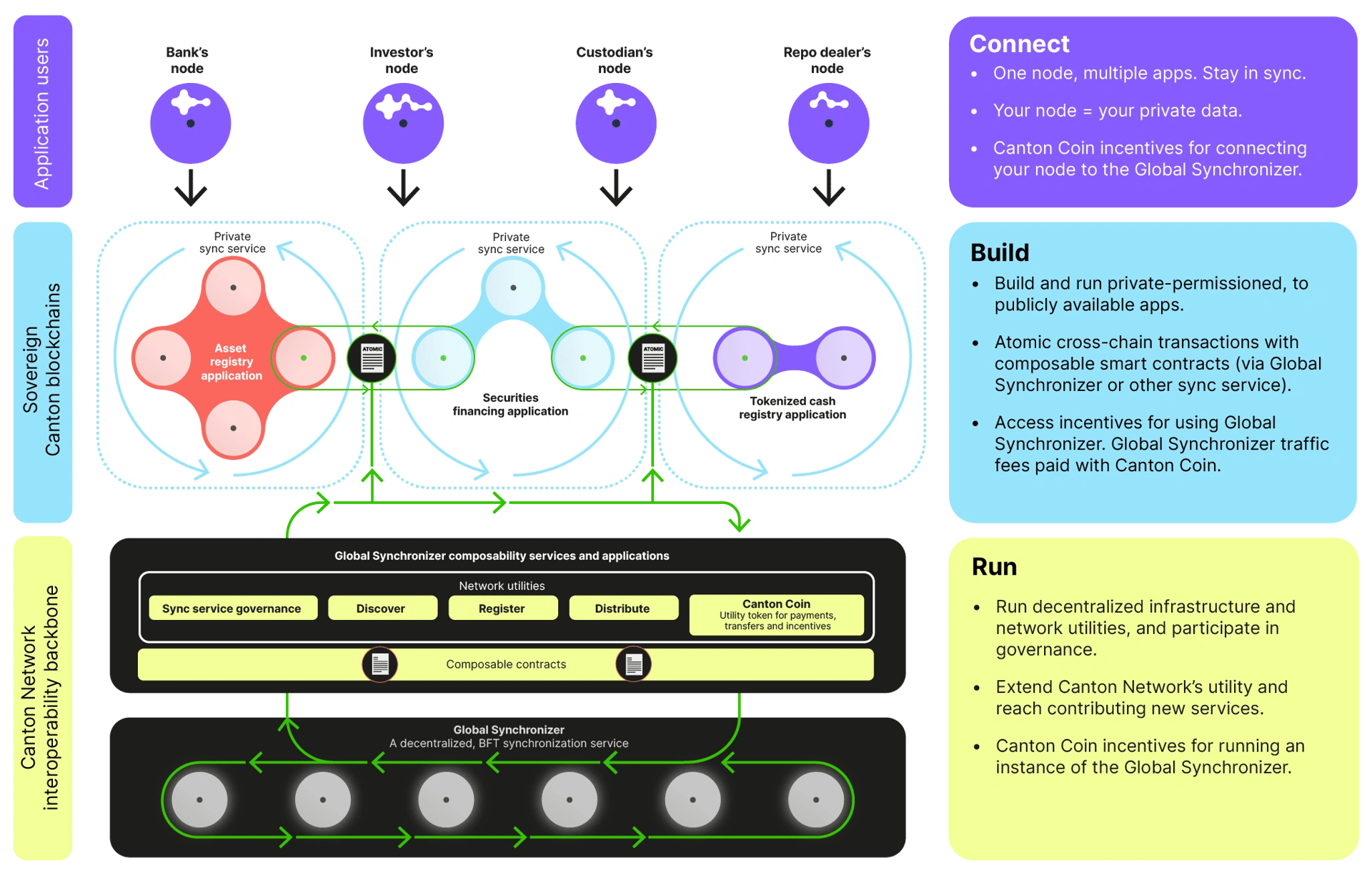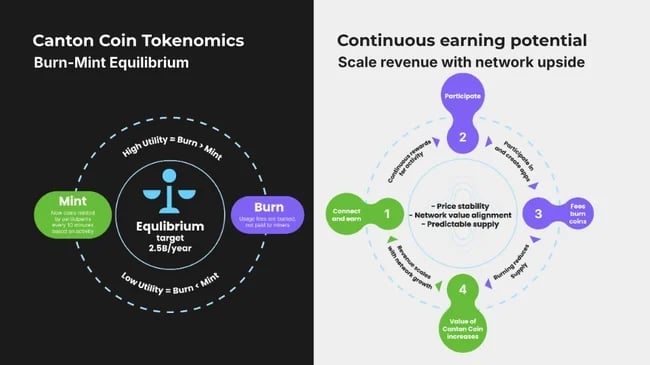Subscribe to wiki
Share wiki
Bookmark
Canton Network
Canton Network
Canton Network is a layer-one, privacy-focused blockchain infrastructure that enables institutions to run interoperable applications while maintaining control over their data. It provides a modular framework that allows otherwise separate ledgers, built with the Daml smart contract language, to connect when needed, facilitating coordinated financial workflows without exposing system-wide activity. [1]
Overview
Canton Network is a public-permissioned blockchain designed to address the specific needs of regulated financial institutions for privacy, control, and interoperability. It functions as a "network of networks," allowing decentralized applications and siloed financial systems to connect and transact in real time, addressing the inefficiencies and risks of manual reconciliation processes. The network's architecture contrasts with traditional blockchains, where all applications must conform to a single, transparent public ledger and compete for shared resources. Instead, Canton provides each participant with a private, cryptographically verifiable projection of the ledger, ensuring they see only the data relevant to them.
Developed by Digital Asset, the network is built to run applications using the Daml smart contract language. Canton's model aims to combine the asset mobility of public blockchains with the configurable privacy and control required for institutional use cases like derivatives, syndicated loans, and repo markets. It is governed by a decentralized model supported by the Canton Foundation and The Linux Foundation, with network participants collectively managing key protocol decisions. The vision for the network has been compared to the internet—a heterogeneous system where independently operated applications can coexist and interoperate securely. [4] [6]
Architecture and Technology

Canton’s architecture is a modular, two-tier system designed to provide privacy, control, and horizontal scalability for institutional applications. It separates the application logic layer (Daml) from the synchronization and execution layer (Canton Protocol). [5]
Daml (Digital Asset Modeling Language)
Daml is an open-source smart contract language purpose-built for multi-party business workflows. It allows developers to define shared data, permissions, and rules while preserving privacy and data consistency. A Daml model outlines the schema for a shared ledger, including which parties must authorize the creation of a contract (signatories), which can view it (observers), and which can exercise specific actions on it (controllers). The language is designed with a "confidential by default" privacy model, where authorization policies are defined directly within the contract code. In Canton's execution model, each party runs on a Validator Node that stores its individual, private projection of the ledger, ensuring participants only see the data and transactions relevant to them. [4] [2]
Canton Protocol
The Canton Protocol is an open-source, privacy-enabled protocol that implements the Daml ledger model. It ensures that the partitioned views of all participants remain consistent subsets of a "virtual" global ledger, without any single party ever holding the ledger in its entirety. The protocol achieves horizontal scalability, as transactions with no data dependencies can be processed in parallel. It uses a two-layer consensus mechanism called "Proof-of-Stakeholder." In the first layer, a contract is replicated only to its stakeholders for local validation. In the second layer, an encrypted transaction request is sent to a sequencing service (a Sync Domain), which assigns a timestamp to establish a definitive order and prevent double-spending. [4]
Synchronization Domains (Sync Domains)
The Sync Domains function serves as the core coordination and messaging layer within Canton. They are responsible for transaction sequencing, timestamping, identity management, and guaranteed message delivery for a group of participants. Each domain is operated by a Canton Service Provider (CSP), which can be a single, centralized organization or a decentralized consortium of Validators (a virtual CSP or vCSP) using a Byzantine Fault Tolerant (BFT) consensus algorithm. This flexibility allows developers to choose which sync domains to use based on specific privacy, regulatory, or performance needs. A single workflow can span multiple domains, and participants can reassign a contract’s synchronization from one domain to another to avoid lock-in. [6] [4]
Global Synchronizer
The Global Synchronizer is a special, shared-key synchronization domain that serves as the decentralized interoperability backbone of the entire Canton Network. It links otherwise separate sync domains to enable atomic settlement and interoperability across applications handling regulated financial assets. It is operated collectively by a group of Super Validators, with no single entity controlling its sequencing or availability. The Global Synchronizer provides consistent ordering, guaranteed message delivery, and cross-domain transaction finality, supporting private workflows while connecting tokenized assets and cash across jurisdictions. The underlying technology is open-sourced through Hyperledger Labs as "Splice," allowing any organization to deploy additional decentralized synchronization domains that integrate with the broader network. [7] [6]
Network Participants and Governance
The Canton ecosystem involves several distinct roles, with governance managed through a decentralized framework involving key operator groups and a non-profit foundation. [10]
Infrastructure Operators
- Validators: These are nodes that participate in operating a distributed sync domain (vCSP). They use BFT consensus to order and confirm transactions within that domain. Application users run their own validator nodes to connect to the network, and these nodes only validate transactions to which they are a direct party, preserving privacy. [4] [11]
- Super Validators: A specialized class of validators responsible for operating and governing the Global Synchronizer. Their duties include validating all Canton Coin transfers, managing shared network infrastructure such as the Canton Name Service, and providing the on-chain oracle for the Canton Coin/USD conversion rate. They form the core of the network's governance body. [9] [8]
Governance Model
The network is governed by the Super Validator Collective (SVC), the group of entities running the Super Validator nodes. This collective votes on key decisions, including protocol upgrades, fee adjustments, designating "featured" applications, and admitting new Super Validators, with a two-thirds majority required for all actions. This decentralized model is supported by the Canton Foundation (formerly the Global Synchronizer Foundation), an independent, U.S.-based entity managed by The Linux Foundation. The foundation's mandate is to ensure fair governance, facilitate community engagement, and maintain the network's shared infrastructure's neutrality. Changes to the network are subject to a formal Canton Improvement Proposal (CIP) process before being voted on by the Super Validators. [9] [3]
Canton Coin (CC)
Canton Coin (CC, also abbreviated as CCN or CNTN) is the native utility token of the Canton Network, primarily used within the Global Synchronizer. It is designed to reward network utility and contribution rather than to encourage speculation. [11]
Fair Launch and Distribution
Canton Coin was launched with an "earned-value" distribution model, in which 100% of tokens in circulation are added to the supply by being earned through verifiable contributions to the network. The launch involved no pre-mined supply, no pre-sale, no special reserves for the foundation, and no early-access allocations for investors or venture firms. This structure directly links token ownership to participation in the ecosystem. [2] [7]
Tokenomics and Utility

The primary utilities of Canton Coin are:
- Transaction Fees: Paying for traffic on the Global Synchronizer and other network services. Fees are denominated in USD to provide cost predictability for enterprise users, but are paid by burning Canton Coin at the current on-chain conversion rate.
- Rewards: Compensating network participants, including infrastructure operators (Validators and Super Validators) and application providers, for their contributions.
- Optional Payments: Serving as an optional payment method within applications built on the network.
The tokenomics are built around a Burn-Mint Equilibrium, a self-regulating mechanism that aligns the token's value with network utility. Fees paid in CC are burned, removing them from circulation, while new coins are minted as rewards. The long-term target is to reach a steady state where the amount of coin burned annually equals the amount minted. Over the first ten years of operation, 100 billion CC are scheduled to be available for minting. Afterward, 2.5 billion CC will be available for minting annually. [8] [7]
The reward distribution model is designed to evolve. In the initial phase after launch (July-December 2024), rewards were weighted towards Super Validators (80%) to bootstrap secure infrastructure. From 2025 to mid-2029, the focus shifts to application and user growth, with application providers becoming eligible for up to 62% of the reward pool. [11]
Partnerships
See something wrong?
